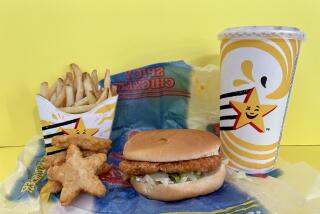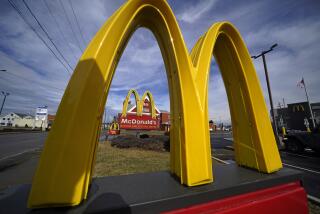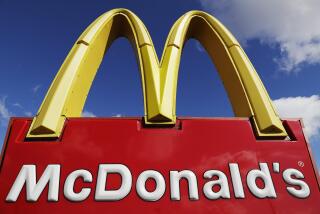Taking a Bite Out of McDonald’s Business
Burger King on Monday introduced a 99-cent menu that’s designed to bolster profits by eliminating costly discounting on the Miami-based chain’s premium burgers.
The 9,500-unit burger chain is betting that the new “Great Tastes” value menu will lure cost-conscious consumers in the door and allow operators to charge heftier prices for bigger sandwiches like the mainstay Whopper.
“It’s a long-term pricing strategy that’s designed to give them some things under a buck but still let them have higher-priced fare,” said Irvine-based restaurant industry analyst Randall Hiatt. “And, by targeting ‘Great Tastes’ in the advertising, they’re clearly going after a McDonald’s weakness.”
Burger King, a unit of Diageo, didn’t disclose how much it will spend on a national advertising campaign that began Monday. The value menu includes the Whopper Jr. sandwich, a five-piece Chicken Tenders entree, a bacon cheeseburger, and medium-sized orders of French fries, soft drinks, milk shakes and onion rings--all regular menu items.
With its value-oriented menu, Burger King has joined other restaurant chains, including Carl’s Jr. and Jack in the Box, that are trying to end the practice of discounting prices on bigger sandwiches.
Burger King has successfully used discounting on various menu items to gain ground on McDonald’s Corp., the fast-food industry leader. Technomic Inc. recently reported that Burger King’s sales rose 5.5% in 1997, compared with a 4.6% domestic increase for McDonald’s.
“Discounting works by getting people in the door, whether it’s Whoppers or Denny’s Grand Slam breakfast for $1.99,” said Hal Seiling, a Carlsbad-based restaurant industry consultant. “But what’s happening is that both McDonald’s and Burger King want to charge what they feel they should be charging for their signature sandwiches.”
But both chains are trying to reverse the practice of discounting prices on their premium products. Early this year, McDonald’s began advertising 29-cent burgers on Thursdays and 39-cent cheeseburgers on Sundays. The ads are designed to give cost-conscious consumers an alternative without discounting prices on Big Macs and other sandwiches that, at full price, can generate fatter profit margins.
Jim Watkins, Burger King’s senior vice president of marketing, described the menu change as “an evolution in the burger wars. What we’re trying to do is make sure that the value offered to our customers is appropriate across the board.”
In addition to battling for share of the burger market, the two chains have been waging a fierce advertising campaign on the French fry front. Burger King has been crowing in advertising that its fries are now the most popular, a claim that McDonald’s is contesting in an ongoing advertising push.
Burger King will release sales information about its new fries later this week, Watkins said. “I can tell you that sales in January, the first full month, exceeded everyone’s expectations.”
In a related development Monday, McDonald’s stock fell $1.63 to close at $53 in New York Stock Exchange trading after investor Warren Buffett’s annual letter to shareholders omitted the fast-food giant from his list of biggest holdings.
More to Read
Inside the business of entertainment
The Wide Shot brings you news, analysis and insights on everything from streaming wars to production — and what it all means for the future.
You may occasionally receive promotional content from the Los Angeles Times.










